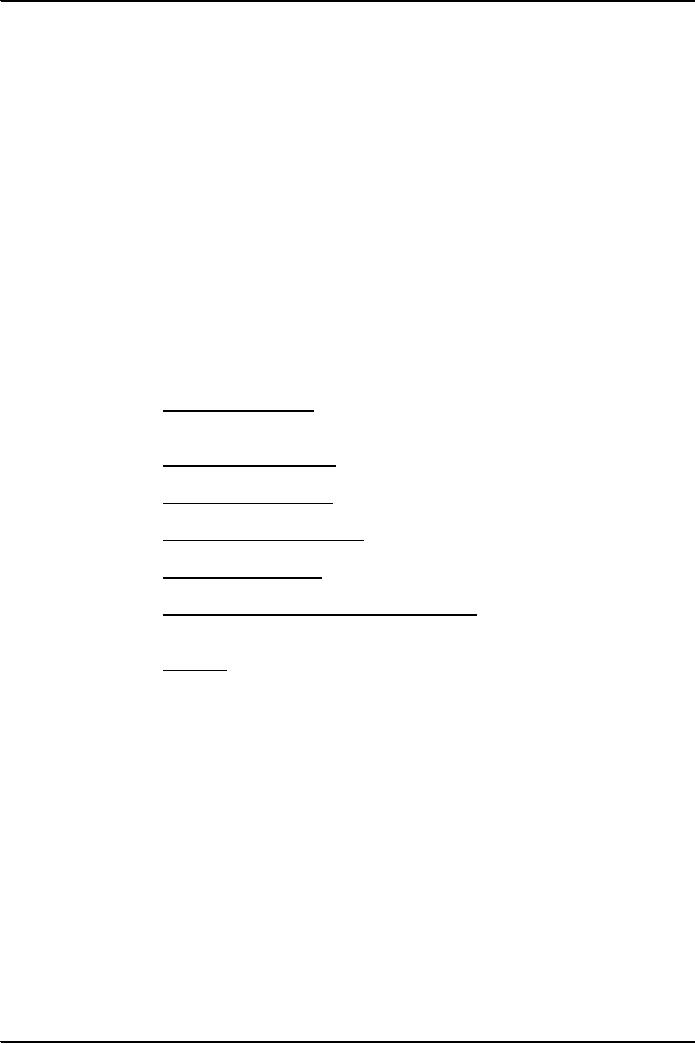 |
Risk Assessment Procedures & Sources of Information |
| << Business Operations |
| Measurement and Review of the Entity’s Financial Performance >> |

Fundamentals
of Auditing ACC 311
VU
Lesson
13
UNDERSTANDING
THE ENTITY AND ITS ENVIRONMENT
AND
ASSESSING THE RISKS OF MATERIAL
MISSTATEMENT
RECAP
Sources
of Obtaining Understanding
Auditor
obtains an understanding of the entity and
environment, including its
internal control
through:
1.
Risk assessment procedures
and sources of information
about the entity and its
environment
including
its internal control.
2. Understanding
the entity and its
environment, including its
internal control.
3.
Assessing the risk of material
misstatement.
4. Communicating
with those charged with
governance and
management.
5.
Documentation
1.
Risk
Assessment Procedures & Sources of
Information
Risk
assessment procedures to obtain an
understanding
a)
Inquiries directed
towards:
� Those
charged with
governance
� Internal
audit personnel
� Middle
management (employees)
� Legal
counsel
� Marketing
or sales personnel
b)
Analytical procedures
� Financial
� Non
financial
c) Observation
and inspection of:
� Observations
of Activities and operations
� Inspection
of Documents and
records
� Reading
Management reports
� Visit
to premises and plant
facilities
2.
Understanding
the Entity and Its
Environment, Including Its
Internal Control
The
auditor's understanding of the entity and
its environment consists of an
understanding of the following
aspects:
a)
External Factors:
� Industry
conditions
� Regulatory
environment
� Macro
economic level factors
b)
Nature of the entity:
� Business
operations
� Investments
� Financing
� Financial
reporting
c)
Objectives and strategies
and the related business
risks
� Potential
related business risk at existence of
objective:
a)
Industry developments
b) New
products and services
c) Expansion of the
business
d) New
accounting requirements
e)
Regulatory requirements
f)
Current and prospective
financing requirements
g) Use
of IT
� Potential
related business risk at implementing a
strategies:
a) Effects
leading to new accounting
requirements
47

Fundamentals
of Auditing ACC 311
VU
d)
Measurement and review of the entity's
financial performance.
e)
Internal control.
2.
Understanding
the Entity and Its
Environment, including Its
Internal Control
The
auditor's understanding of the entity and
its environment consists of an
understanding of the
following
aspects:
(a)
Industry,
regulatory, and other external factors,
including the applicable financial
reporting
framework
(like; insurance companies,
leasing companies, banking
companies, textile
industry
etc.).
(b)
Nature
of the entity, including the entity's
selection and application of
accounting policies
(like;
sugar, textile, hotel, tourism,
services, etc.).
(c)
Objectives
and strategies and the
related business risks that
may result in a
material
misstatement
of the financial statements (like; growth
maximization, cost effectiveness,
quality
leadership, downsizing, etc.).
(d)
Measurement
and review of the entity's financial
performance.
(e)
Internal
control.
c)
Objectives
and Strategies and Related Business
Risks
The
auditor should obtain an understanding of the entity's
objectives and strategies
and the related
business
risks that may result in
material misstatement of the financial
statements.
Business
Risk is the risk that
objectives and strategies would not be
met
Examples
of matters an auditor may
consider include the following:
� Existence
of objectives with reference
to:
Industry
developments (a potential related
business risk might be, for
example,
that
the entity does not have the
personnel or expertise to deal
with the changes
like
technological changes in the industry).
New
products and services (a potential
related business risk might
be, for example,
that
there is increased product
liability).
Expansion of the
business (a potential related
business risk might be, for
example,
that
the demand has not been
accurately estimated).
New
accounting requirements (a potential
related business risk might
be, for
example,
incomplete or improper implementation, or increased
costs).
Regulatory
requirements (a potential related
business risk might be, for
example
that
there is increased legal
exposure).
Current
and prospective financing
requirements (a potential related
business risk
might
be, for example, the loss of
financing due to the entity's inability
to meet
requirements).
Use of
IT (a potential related business risk
might be, for example,
that systems and
processes
are incompatible).
� Effects of
implementing a strategy, particularly any
effects that will lead to
new accounting
requirements
(a potential related business risk
might be, for example,
incomplete or
improper
implementation)
The
auditor should keep in mind
that business risk is broader than the
risk of material misstatement.
Business
risks, at times, do not
cause any misstatement in the financial
statements but affect the going
concern.
Conditions
and events that may indicate
risks of material misstatements
are as follows:
The
following are examples of
conditions and events that
may indicate the existence of risks of
material
misstatement.
The examples provided cover
a broad range of conditions and
events; however, not
all
conditions
and events are relevant to
every audit engagement and
the list of examples is not
necessarily
complete.
� Operations in
regions that are
economically unstable, for
example, countries with
significant
currency
devaluation or highly inflationary
economies.
� Operations
exposed to volatile markets,
for example, futures trading.
� High
degree of complex regulation.
� Going
concern and liquidity issues
including loss of significant
customers.
� Constraints
on the availability of capital and
credit.
48

Fundamentals
of Auditing ACC 311
VU
�
Changes
in the industry in which the entity
operates.
�
Changes
in the supply chain.
�
Developing
or offering new products or
services, or moving into new
lines of business.
�
Expanding
into new locations.
�
Changes
in the entity such as large
acquisitions or reorganizations or other
unusual events.
�
Entities
or business segments likely to be
sold.
�
Complex
alliances and joint
ventures.
�
Use of
off-balance-sheet finance,
special-purpose entities, and
other complex financing
arrangements.
�
Significant
transactions with related
parties.
�
Lack of
personnel with appropriate accounting
and financial reporting
skills.
�
Changes
in key personnel including
departure of key
executive.
�
Weaknesses
in internal control, especially
those not addressed by
management.
�
Inconsistencies
between the entity's IT strategy and
its business
strategies.
�
Changes
in the IT environment.
�
Installation
of significant new IT systems related to
financial reporting.
�
Inquiries
into the entity's operations or financial results by
regulatory or government bodies.
�
Past
misstatements, history of errors or a
significant amount of adjustments at period
end.
�
Significant amount
of non-routine or non-systematic
transactions including
inter-company
transactions
and large revenue
transactions at period
end.
�
Transactions
that are recorded based on
management's intent, for
example, debt refinancing,
assets
to be
sold and classification of
marketable securities.
�
Application
of new accounting
pronouncements.
�
Accounting
measurements that involve complex
processes.
�
Events or
transactions that involve significant
measurement uncertainty, including
accounting
estimates.
�
Pending
litigation and contingent
liabilities for example,
sales warranties, financial
guarantees and
environmental
remediation.
49
Table of Contents:
- AN INTRODUCTION
- AUDITORS’ REPORT
- Advantages and Disadvantages of Auditing
- OBJECTIVE AND GENERAL PRINCIPLES GOVERNING AN AUDIT OF FINANCIAL STATEMENTS
- What is Reasonable Assurance
- LEGAL CONSIDERATION REGARDING AUDITING
- Appointment, Duties, Rights and Liabilities of Auditor
- LIABILITIES OF AN AUDITOR
- BOOKS OF ACCOUNT & FINANCIAL STATEMENTS
- Contents of Balance Sheet
- ENTITY AND ITS ENVIRONMENT AND ASSESSING THE RISKS OF MATERIAL MISSTATEMENT
- Business Operations
- Risk Assessment Procedures & Sources of Information
- Measurement and Review of the Entity’s Financial Performance
- Definition & Components of Internal Control
- Auditing ASSIGNMENT
- Benefits of Internal Control to the entity
- Flow Charts and Internal Control Questionnaires
- Construction of an ICQ
- Audit evidence through Audit Procedures
- SUBSTANTIVE PROCEDURES
- Concept of Audit Evidence
- SUFFICIENT APPROPRIATE AUDIT EVIDENCE AND TESTING THE SALES SYSTEM
- Control Procedures over Sales and Debtors
- Control Procedures over Purchases and Payables
- TESTING THE PURCHASES SYSTEM
- TESTING THE PAYROLL SYSTEM
- TESTING THE CASH SYSTEM
- Controls over Banking of Receipts
- Control Procedures over Inventory
- TESTING THE NON-CURRENT ASSETS
- VERIFICATION APPROACH OF AUDIT
- VERIFICATION OF ASSETS
- LETTER OF REPRESENTATION VERIFICATION OF LIABILITIES
- VERIFICATION OF EQUITY
- VERIFICATION OF BANK BALANCES
- VERIFICATION OF STOCK-IN-TRADE AND STORE & SPARES
- AUDIT SAMPLING
- STATISTICAL SAMPLING
- CONSIDERING THE WORK OF INTERNAL AUDITING
- AUDIT PLANNING
- PLANNING AN AUDIT OF FINANCIAL STATEMENTS
- Audits of Small Entities
- AUDITOR’S REPORT ON A COMPLETE SET OF GENERAL PURPOSE FINANCIALSTATEMENTS
- MODIFIED AUDITOR’S REPORT